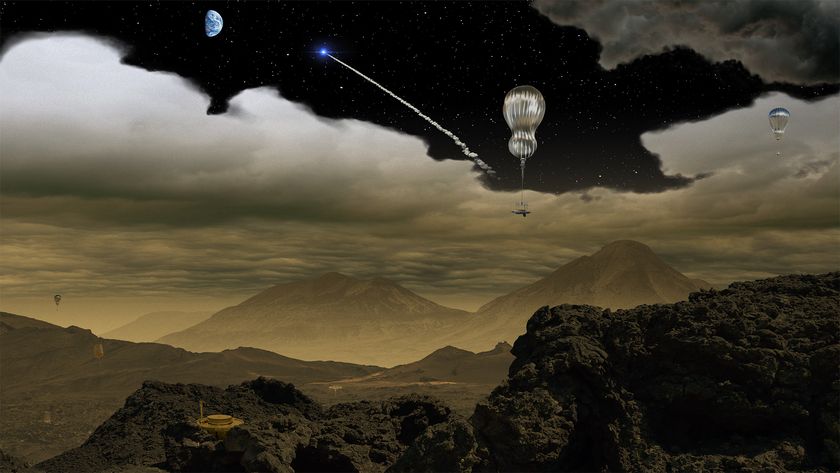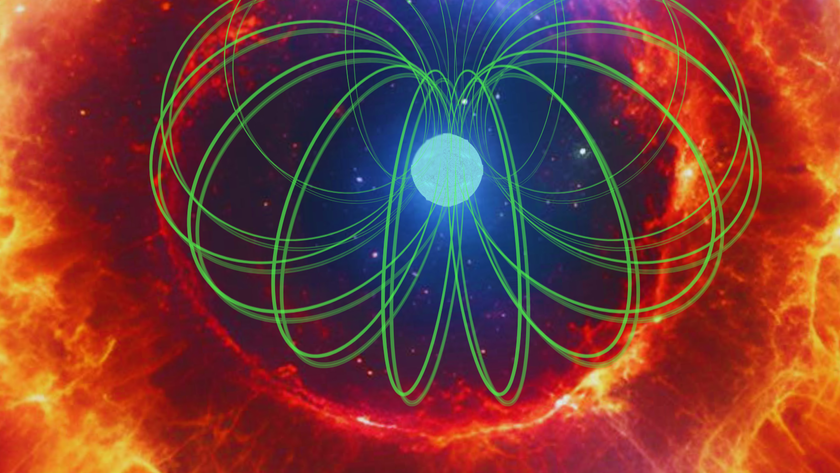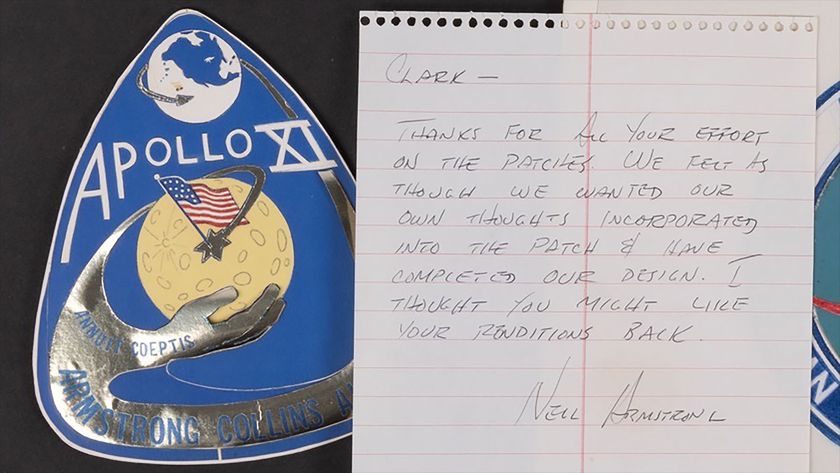Rhea: A guide to Saturn's 'rocky snowball' moon
Rhea, Saturn's second-largest moon, is a rocky snowball that has its own ring system and a weird "two-faced" surface.
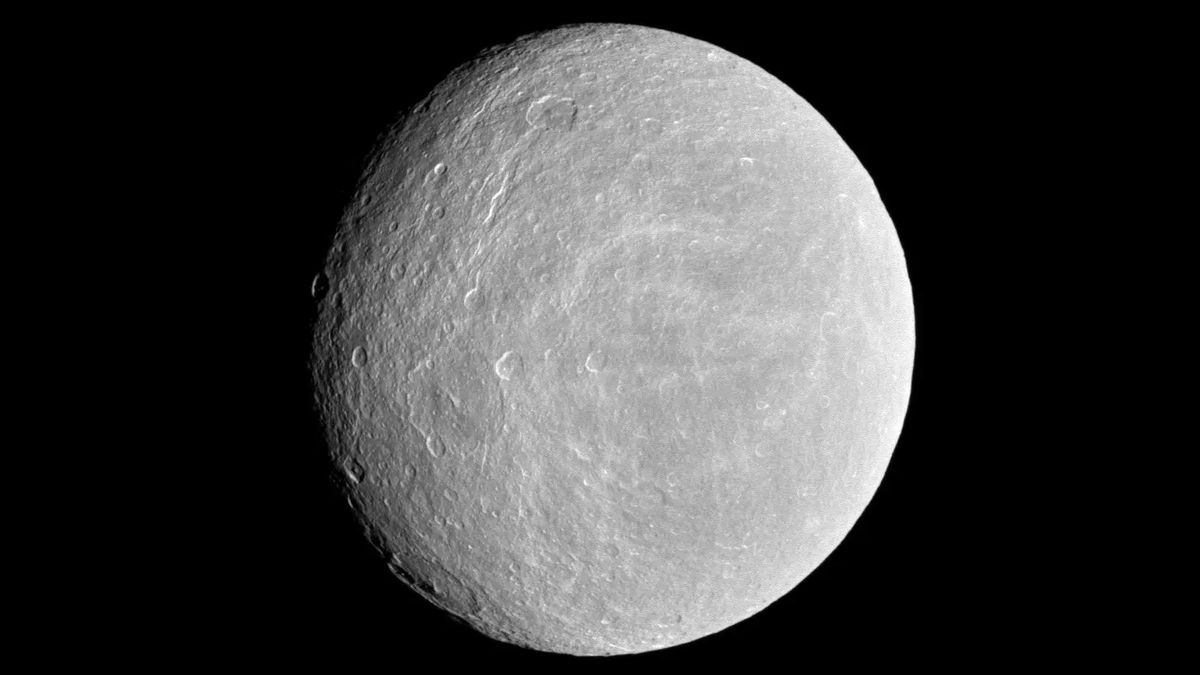
Rhea is the second-largest moon of the gas giant planet Saturn. It was discovered by Italian astronomer Giovanni Cassini on Dec. 23, 1672.
With a radius of 475 miles (764 kilometers), Rhea is around one-third the size of Saturn's largest moon, Titan, which is the second-largest moon in the solar system after Jupiter's moon Ganymede.
Rhea is the ninth-largest moon in the solar system, after Ganymede, Titan, Callisto, Io, Earth's moon, Europa, Triton and Titania.
Related: The 10 weirdest moons in the solar system
Rhea orbits Saturn at a distance of 327,500 miles (527,000 km) and thus is farther from Saturn than the moons Dione and Tethys are. It has an orbital period of around 4.52 Earth days, according to Britannica. Like Dione and Tethys, as well as Earth's moon, Rhea is tidally locked, meaning it always has one side facing Saturn and one side pointing to space.
Rhea is named after the Greek "mother of the gods," a Titan who was the daughter of Uranus and Gaea (also spelled Gaia), according to Britannica. She married her brother Cronus and was the mother of Zeus, Poseidon and Hades.
Rhea FAQs
What is special about Saturn's moon Rhea?
Rhea is the second-largest moon of Saturn and the ninth-largest moon in the solar system. Its composition is around three-quarters ice and one-quarter rock. One side of Rhea is heavily cratered, while the other is fairly smooth, indicating it has undergone a resurfacing event in its history.
Does Rhea have rings?
Yes, Rhea's ring system was discovered by the Cassini spacecraft in 2008. It was the first ring system ever found around a moon.
What was the moon Rhea named after?
Saturn's moon Rhea is named after the Greek goddess Rhea, who is considered the "mother of the gods," including Zeus, in Greek mythology.
What is Rhea made of?
Like Titan, Rhea is an ice moon with a frosty surface. The density of Rhea is around 1.2 times that of water, suggesting that it is composed of one-quarter solid rock and three-quarters ice.
Observations of the inertia about Rhea's axis made by the Cassini-Huygens spacecraft showed this density to be greater than would be expected for a body with a rocky core, implying that rock is mixed throughout the body of Rhea rather than concentrated mainly in one region. This led NASA to describe Rhea as a "frozen dirty snowball."
In 2010, the Cassini mission was also responsible for discovering that Rhea has a very thin atmosphere, or an exosphere, of oxygen and carbon dioxide. This was the first time oxygen had been detected around a world other than Earth.
According to NASA, this oxygen is caused by the magnetic field of Saturn rotating over Rhea and pelting the moon's water-ice surface with energetic charged particles trapped in that field. This results in chemical reactions that release oxygen. The source of carbon dioxide in the diffuse atmosphere of Rhea is undetermined.
The high reflectivity of Rhea indicates that, like Dione and Tethys, it has a surface composed of water ice. Also, like the surfaces of these two Saturn moons, Rhea has a surface temperature of up to minus 281 degrees Fahrenheit (minus 174 degrees Celsius) in sunlit areas and as low as around minus 364 F (minus 220 C) in shaded regions.
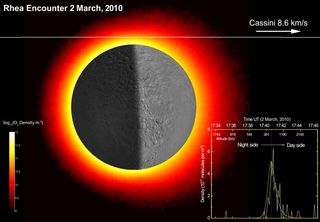
The two-faced moon
The surface of Rhea is unique, too. The water and other materials on the moon's frozen surface are cold enough to behave like rock, meaning they retain a record of Rhea's impact history, according to Britannica. It is the most heavily crated on its brightest hemisphere, the one which leads its orbit around the sun.
The face of Rhea appears to be divided into two distinct regions, according to NASA. In 1980 and 1981, the Voyager 1 and Voyager 2 spacecraft got the first up-close views of Rhea. They revealed that one region is bright and covered in craters larger than 25 miles (40 km) across. At the equator, though, the craters are smaller. This suggests that many years ago, a resurfacing event "refreshed" the surface in these less-cratered regions.
Both Dione and Tethys have smoother surfaces than Rhea and are much less cratered. Though this could be because Rhea is more intensely bombarded by space rocks, it could also indicate regions where liquid water has breached the surfaces of Dione and Tethys and refrozen, thereby covering craters. This may be because Rhea is too far from Saturn to be tidally squeezed by the planet's gravity — a process that causes internal warming for the closer moons.
Additionally, the Voyager probes' observations of Rhea showed lines running for tens to hundreds of miles and occasionally bisecting plains and craters on the moon's surface, some of which are bright and others which are fainter. Follow-up investigations by Cassini in 2006 showed that these are fractures in Rhea's icy shell that have created canyons.
These canyons are bright because darker material has fallen from their walls, and they can be over 1,000 feet (several hundred meters) tall. These features indicate that Rhea may have been geologically active in its history.
The rings of Rhea
Saturn is famous for its rings, but Rhea seems to have a tenuous ring system of its own. The ring system of Rhea comprises three dense but narrow bands in a dust halo around the Saturnian moon.
The discovery was made in 2008 when Cassini observed that energetic electrons trapped in the magnetosphere of Saturn were being depleted around Rhea. The best explanation for the pattern of this depletion was deemed to be solid material in a disk around Rhea's equator that blocked electrons before they could reach Cassini's instruments. This was the first time a disk system had been observed around a moon.
According to the European Space Agency, the apparent debris disk around Rhea measures several thousand kilometers from end to end. The particles that make up the cloud and any embedded rings are believed to range from pebble- to boulder-size. A further dust cloud could extend beyond this, reaching around 3,700 miles (5,900 km) from the heart of Rhea, or around eight times the moon's radius.
Additional resources
Watch this simulation from the European Space Agency to see how some large moons of Saturn, including Rhea, revolve around the gas giant. In this NASA video, learn about the process that may have created the rings and moons of Saturn. See the final moments of the Cassini mission, which was vital to our understanding of Rhea and the other moons of Saturn.
Bibliography
Rhea, NASA, [Accessed 12/11/23], https://science.nasa.gov/saturn/moons/rhea/]
Rhea Information Page, NASA Planetary Data System, [Accessed 12/11/23], [https://arcnav.psi.edu/urn:nasa:pds:context:target:satellite.saturn.rhea/missions]
Rhea and Rings, [Accessed 12/11/23], [https://science.nasa.gov/resource/rhea-and-rings/]
Rhea, Britannica, [Accessed 12/11/23], [https://www.britannica.com/topic/Rhea-Greek-goddess]
Rhea, Britannica, [Accessed 12/11/23], [https://www.britannica.com/topic/Rhea-astronomy]
Saturn's moon Rhea may also have rings, European Space Agency https://www.esa.int/Science_Exploration/Space_Science/Cassini-Huygens/Saturn_s_moon_Rhea_may_also_have_rings
Join our Space Forums to keep talking space on the latest missions, night sky and more! And if you have a news tip, correction or comment, let us know at: community@space.com.
Get the Space.com Newsletter
Breaking space news, the latest updates on rocket launches, skywatching events and more!

Robert Lea is a science journalist in the U.K. whose articles have been published in Physics World, New Scientist, Astronomy Magazine, All About Space, Newsweek and ZME Science. He also writes about science communication for Elsevier and the European Journal of Physics. Rob holds a bachelor of science degree in physics and astronomy from the U.K.’s Open University. Follow him on Twitter @sciencef1rst.
